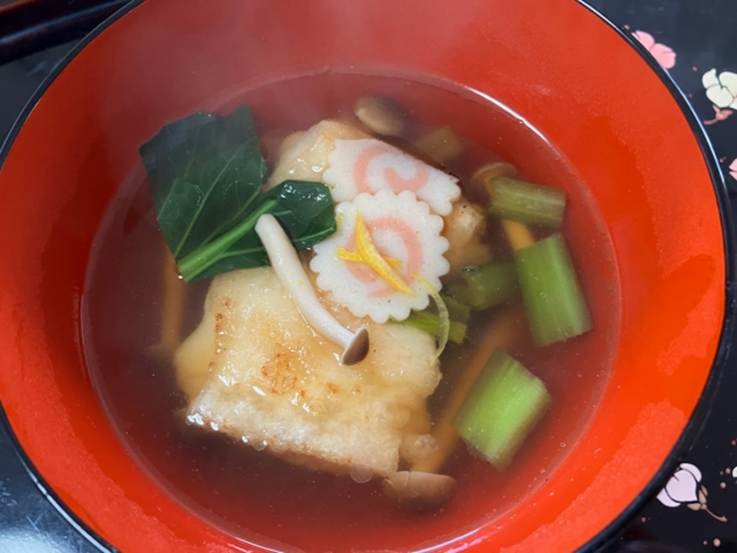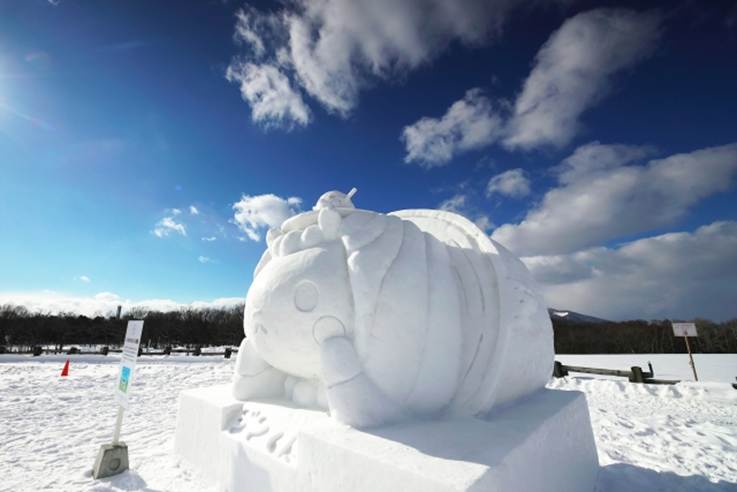Japan’s New Year, or Oshogatsu, is the country’s most important holiday, celebrated from January 1st to 3rd. It is a time for family gatherings, renewal, and honoring cherished traditions. Preparations include deep cleaning homes to welcome good fortune, decorating with kadomatsu (pine and bamboo arrangements), and sending Nengajō (New Year’s cards) to friends and relatives. On New Year’s Eve, families gather to enjoy toshikoshi soba (year-crossing noodles) and listen to temple bells ring 108 times, symbolically cleansing the worries of the past year. Beyond rituals, Oshogatsu offers a unique blend of festive flavors, cultural ceremonies, and scenic winter landscapes, creating an unforgettable seasonal experience.
Dive into our blog on “Where to Go for a Sake Tour in Japan” for more on festive culinary experiences.
Festive Flavors: Year-End Food Traditions in Japan
Osechi-ryōri: Symbolism in Every Bite

Osechi-ryōri consists of multi-tiered lacquer boxes (Jubako) filled with carefully prepared dishes, each symbolizing good fortune and prosperity for the coming year. Originating in the Heian period, these meals were made in advance so families could enjoy the holiday without cooking during the first days of January.
Common dishes and their meanings:
- Kuromame (sweet black beans): health and diligence
- Kazunoko (herring roe): prosperity of descendants
- Tazukuri (dried sardines): a bountiful harvest
- Kohaku Namasu (pickled daikon and carrot): peace and happiness
Every item is prepared with its symbolic meaning in mind, making Osechi not just a meal, but a culinary wish for a happy, prosperous year ahead.
Ozoni: The New Year’s Soup

Ozoni is a traditional Japanese soup featuring mochi rice cakes in a savory broth, with variations that reflect regional customs.
- In Kansai, the soup is often richer, with a clear, miso-based broth and round mochi, symbolizing purity.
- In Kanto, it typically features a soy-sauce-based clear broth with square mochi, representing strength.
Ingredients are carefully chosen to convey good fortune, health, and prosperity, and the soup is traditionally enjoyed as breakfast on New Year’s Day. Ozoni not only nourishes the body but also connects families to centuries-old traditions, making it a central part of Oshogatsu celebrations.
Want more Tokyo food inspiration? See our “Tokyo Food Tour: Taste your way through the heart of Japan’s vibrant food scene!” article.
City Lights & Winter Illumination Tours

Spending New Year’s in Japan isn’t just about traditions and cuisine—the country also comes alive with spectacular winter illuminations. From city streets to parks, millions of lights create magical landscapes, perfect for evening strolls, festive photos, and immersing yourself in the seasonal charm.
Tokyo’s Winter Illuminations
Tokyo Midtown
Tokyo Midtown’s winter illuminations are famous for their champagne-colored lights that transform the Midtown Garden into a magical wonderland. The Ensemble Lights display uses hundreds of thousands of lights, accompanied by music and special effects like bubble showers and simulated snowfall, creating a truly fantastical winter atmosphere.
Marunouchi
Along a 1.2-kilometer stretch, Marunouchi blends the historic architecture of Tokyo Station with modern lighting displays along Naka-dori. Around 300 trees are illuminated with approximately 820,000 energy-efficient LEDs, complemented by seasonal pop-up shops, an ice-skating rink, and a Christmas market. It’s a festive hub for locals and tourists alike.
Roppongi
Roppongi Hills Keyakizaka Illumination features about 800,000 blue and white LED lights along a 400-meter tree-lined street, creating a “Snow & Blue” theme. Set against the backdrop of Tokyo Tower, it’s a photographer’s dream and a favorite spot for visitors seeking a dazzling, festive atmosphere.
Other Notable Illuminations

Yokohama’s Yoru no Yo
Yokohama’s Yoru no Yo, also known as “Yokohama of Light at Night,” is a waterfront spectacle that combines lights, music, and interactive displays. The port area is transformed annually into a large-scale art installation, celebrating Yokohama’s heritage with synchronized illuminations and captivating music shows.
Ashikaga Flower Park
Located in Tochigi Prefecture, Ashikaga Flower Park hosts one of Japan’s top three illumination events, featuring over 5 million decorative lights. The park becomes a luminous wonderland with themed areas like the “Miracle Great Wisteria,” Rose Garden of Light, and Flower Castle, blending winter flora and sparkling lights.
Umeda Sky Building
The Umeda Sky Building combines architectural beauty with festive illumination. Its first-floor plaza features a 25-meter LED mapping tree, while the circular, open-air rooftop walkway is adorned with lights, offering panoramic nighttime views of Osaka’s skyline.
Looking for more night-life and city tour ideas? Explore “5 Sake Bars You Should Visit on a Night Out in Tokyo”.
Off-Season Adventures

For travelers looking to experience a quieter, more unique side of Japan during the New Year, winter offers off-season adventures and lesser-known destinations. Beyond the bustling cities and festive illuminations, Japan’s snowy landscapes, hot springs, and wildlife provide unforgettable experiences for those willing to explore.
Exploring Japan’s Winter Wonders
Sapporo Snow Festival
The Sapporo Snow Festival is a world-renowned winter event, famous for its intricate, large-scale snow and ice sculptures. The main site at Odori Park showcases massive monuments, famous landmarks, pop culture figures, and delicate ice carvings. Additional activities take place at the Tsudome site, including slides, play areas, and food stalls, making it a perfect destination for families and art enthusiasts alike.
Onsen Retreats
Winter is the perfect time to soak in natural hot springs surrounded by snow-covered landscapes. Notable onsen destinations include:
- Kusatsu Onsen (Gunma): Mineral-rich waters with a traditional atmosphere
- Hakone (Kanagawa): Stunning views of Mt. Fuji, close to Tokyo
- Kinosaki Onsen (Hyogo): Historic town with seaside charm and local seafood
Other top spots such as Kurokawa Onsen (Kumamoto), Noboribetsu Onsen (Hokkaido), and Arima Onsen (Hyogo) offer mountain scenery, volcanic landscapes, and immersive ryokan experiences for a full winter retreat.
Winter Wildlife
Japan’s winter landscapes are home to fascinating wildlife. In Hokkaido, you can spot red-crowned cranes, Steller’s sea eagles, and Ezo deer. In Nagano, visit Jigokudani Monkey Park to see snow monkeys bathing in hot springs. For birdwatching and nature exploration, Fuji-Hakone-Izu National Park offers forests around Mount Fuji for winter birds like spotted nutcrackers and Eurasian bullfinches, while Lake Yamanaka attracts waterfowl such as Mandarin ducks and crested grebes. These experiences highlight the serene, natural side of Japan in winter, away from the crowds.
Lesser-Known Destinations

If you’re seeking unique winter experiences away from the crowds, Japan offers several hidden gems that showcase both natural beauty and cultural heritage.
Gotō Islands
Part of Nagasaki Prefecture, the Gotō Islands provide a tranquil escape with volcanic landscapes and a fascinating history of hidden Christian sites. Visitors can explore numerous historic churches, enjoy scenic viewpoints, and sample local specialties such as Goto udon. While the region experiences cold winters, snow is rare, making sightseeing comfortable. Late winter brings crisp air and magical light, offering a serene atmosphere distinct from the busy peak season.
Joetsu, Niigata
Located in southwestern Niigata Prefecture, Joetsu is famous for its record snowfall and traditional winter activities. Known as the birthplace of Japanese skiing, the area offers ski resorts as well as cultural experiences.
Highlights include:
- Corridor of Lights: An annual event in February where around 100,000 candles illuminate snow-covered streets, creating a magical winter spectacle.
- Gangi Walkways: A network of covered walkways in the Takada District, allowing residents and visitors to move comfortably during heavy snowfall.
These destinations provide a different, authentic perspective of Japan in winter, combining natural beauty, cultural heritage, and seasonal charm.

Japan’s New Year season offers an unforgettable blend of tradition, celebration, and natural beauty. From savoring symbolic dishes like Osechi-ryōri and Ozoni, to strolling beneath dazzling winter illuminations, and exploring off-season adventures in serene landscapes or hidden destinations, there is truly something for every traveler.
Whether you’re drawn to festive flavors, vibrant city lights, or tranquil winter escapes, immersing yourself in Japan during this special time allows you to experience the heart of its culture, heritage, and seasonal charm. Embrace the magic of Oshogatsu and discover the unique and memorable experiences that only a Japanese New Year can offer. If you’re planning your winter trip, check out our guides to 10 Winter Activities to Do in Japan, How to Tour Japan on a Budget, and Hotels in Tokyo to Make Your Trip A Breeze.
